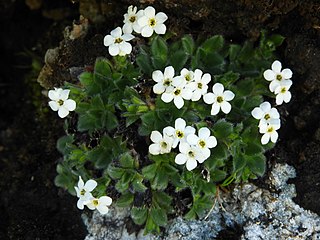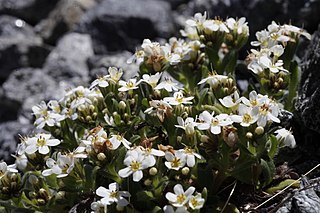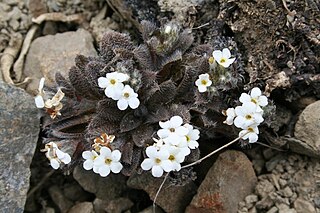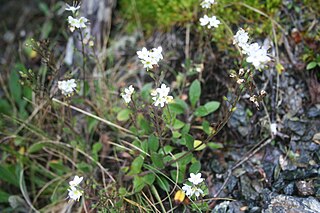
Myosotis pansa subsp. pansa, also known as the Waitakere forget-me-not, is a subspecies of flowering plant in the family Boraginaceae, endemic to the North Island of New Zealand. Lucy Moore described the variety M. petiolata var. pansa in 1961, and it was transferred to a subspecies of M. pansa by Heidi Meudt, Jessica Prebble, Rebecca Stanley and Michael Thorsen in 2013. Plants of this species of forget-me-not are perennial rosettes with ebracteate inflorescences and white corollas with exserted stamens.

Myosotis retrorsa is a species of flowering plant in the family Boraginaceae, endemic to the South Island of New Zealand. Heidi Meudt, Jessica Prebble and Rowan Hindmarsh-Walls described the species. Plants of this species of forget-me-not are perennial with a prostrate habit, bracteate inflorescences, and white corollas.

Myosotis lyallii is a species of flowering plant in the family Boraginaceae, endemic to New Zealand. Joseph Dalton Hooker described the species in 1853. Plants of this species of forget-me-not are perennial with a prostrate habit, bracteate or partially-bracteate inflorescences, and white corollas.

Myosotis lyalliisubsp. elderi is a subspecies of flowering plant in the family Boraginaceae, endemic to New Zealand. Lucy Moore described Myosotis elderi in 1961, and Heidi Meudt and Jessie Prebble treated it as a subspecies of M. lyallii in 2018. Plants of this subspecies of forget-me-not are perennial with a prostrate habit, bracteate inflorescences, and white corollas with partially exserted anthers.

Myosotis concinna is a species of flowering plant in the family Boraginaceae, endemic to the South Island of New Zealand. Thomas Cheeseman described the species in 1885. Plants of this species of forget-me-not are large, perennial rosettes which form loose tufts or clumps, with ebracteate, erect inflorescences, and yellow corollas.

Myosotis laeta is a species of flowering plant in the family Boraginaceae, endemic to ultramafic areas of the Sounds-Nelson area of the South Island of New Zealand. Thomas Cheeseman described the species in 1885. Plants of this species of forget-me-not are perennial rosettes which form loose tufts or clumps, with ebracteate, erect inflorescences, and white corollas.

Myosotis rakiura is a species of flowering plant in the family Boraginaceae, endemic to southern South Island and Stewart Island/Rakiura of New Zealand. Joseph Beattie Armstrong described the species in 1881. Plants of this species of forget-me-not are perennial rosettes which form loose tufts or clumps, with ebracteate, erect inflorescences, and white corollas with exserted stamens.

Myosotis brockiei is a species of flowering plant in the family Boraginaceae, endemic to southern South Island of New Zealand. Lucy Moore and Margaret Simpson described the species in 1973. Plants of this species of forget-me-not are perennial rosettes which form loose tufts or clumps, with ebracteate, erect inflorescences, and white corollas with exserted stamens.

Myosotis brockieisubsp. brockiei is a subspecies of flowering plant in the family Boraginaceae, endemic to southern South Island of New Zealand. Lucy Moore and Margaret Simpson described M. brockiei in 1973. Plants of this subspecies of forget-me-not are perennial rosettes which form caespitose tufts or clumps, with ebracteate, erect inflorescences, and white corollas with exserted stamens.

Myosotis goyenii is a species of flowering plant in the family Boraginaceae, endemic to the South Island of New Zealand. Donald Petrie described the species in 1891. Plants of this species of forget-me-not are perennial rosettes which form loose tufts or clumps, with ebracteate, erect inflorescences, and white corollas with partly exserted or fully included stamens.

Myosotis goyeniisubsp. goyenii is a subspecies of flowering plant in the family Boraginaceae, endemic to southern South Island of New Zealand. Donald Petrie described the species M. goyenii in 1891. Plants of this subspecies of forget-me-not are perennial rosettes which form loose clumps, with ebracteate, erect inflorescences, and white corollas with partly exserted stamens.

Myosotis goyeniisubsp. infima Meudt & Heenan is a subspecies of flowering plant in the family Boraginaceae, endemic to central South Island of New Zealand. Heidi Meudt and Peter Heenan described this subspecies in 2021. Plants of this subspecies of forget-me-not are perennial rosettes which form caespitose clumps, with ebracteate, erect inflorescences, and white corollas with fully incluced stamens.

Myosotis traversii is a species of flowering plant in the family Boraginaceae, endemic to the South Island of New Zealand. Joseph Dalton Hooker described this species in 1864. Plants of this species of forget-me-not are perennial rosettes which form tufts or clumps, with ebracteate, erect inflorescences, and white or yellow corollas with partly exserted stamens.

Myosotis traversiisubsp. traversii is a subspecies of flowering plant in the family Boraginaceae, endemic to the northern South Island of New Zealand. Joseph Dalton Hooker described the species M. traversii in 1864. Plants of this subspecies of forget-me-not are perennial rosettes which form tufts or clumps, with ebracteate, erect inflorescences, and white or yellow corollas with partly exserted stamens.

Myosotis traversiisubsp. cantabrica is a subspecies of flowering plant in the family Boraginaceae, endemic to the central South Island of New Zealand. Lucy Moore described M. traversii var. cantabrica in 1961 and Heidi Meudt changed its rank to subspecies in 2021. Plants of this subspecies of forget-me-not are perennial rosettes which form tufts or clumps, with ebracteate, erect inflorescences, and white or yellow corollas with partly exserted stamens.

Myosotis saxatilis is a species of flowering plant in the family Boraginaceae, endemic to New Zealand. Donald Petrie described this species in 1918. Plants of this species of forget-me-not are perennial rosettes with ebracteate inflorescences and white corollas with stamens that are fully included in the corolla tube or sometimes partly exserted.

Myosotis australis is a species of flowering plant in the family Boraginaceae, native to New Zealand, Australia and New Guinea. Robert Brown described this species in 1810. Plants of this species of forget-me-not are perennial rosettes with ebracteate inflorescences and white or yellow corollas with stamens that are fully included in the corolla tube or sometimes partly protruded.

Myosotis australissubsp. australis is a subspecies of flowering plant in the family Boraginaceae, native to New Zealand and Australia. Robert Brown described M. australis in 1810. Plants of this subspecies of forget-me-not are perennial rosettes with ebracteate inflorescences and white or yellow corollas with stamens that are fully included in the corolla tube or sometimes partly protruded.

Myosotis australissubsp. saruwagedica is a subspecies of flowering plant in the family Boraginaceae, endemic to New Guinea. August Brand described the species M. saruwagedica in 1929 and it was considered to be a synonym or a subspecies of M. australis by subsequent authors. Plants of this subspecies of forget-me-not are perennial rosettes with ebracteate inflorescences and white or yellow corollas with stamens that are fully included in the corolla tube or sometimes partly protruded.

Myosotis oreophila is a species of flowering plant in the family Boraginaceae, endemic to the South Island of New Zealand. Donald Petrie described the species in 1896. Plants of this species of forget-me-not are perennial rosettes with ebracteate inflorescences and white corollas with stamens that are partially exserted.



















